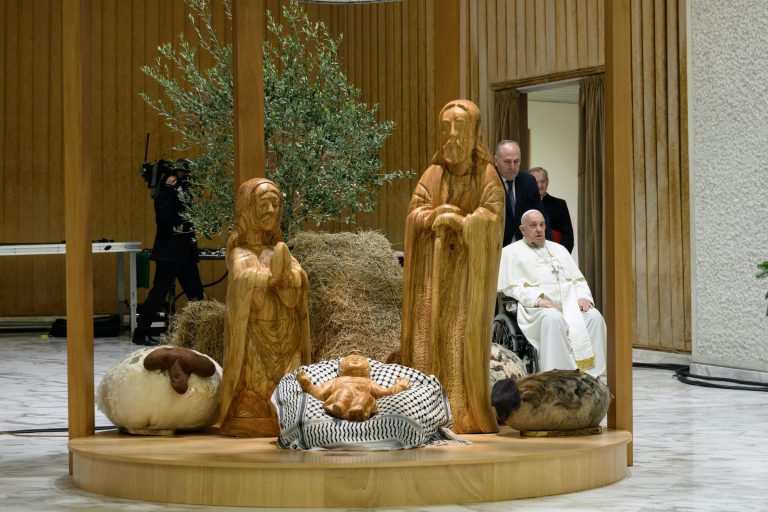On Saturday (December 7), Pope Francis and the Holy See unveiled a nativity scene showing a wooden sculpture of the baby Jesus lying in a hood in a manger, a scene that polarized the world. It was a symbol of solidarity with Palestine that sparked both praise and outrage. As of today (December 11), the statue, which caused an international sensation, has disappeared from the site along with the entire manger and the model of the Baby Jesus.
Initially reported by Christian and Italian news media, the manger, baby Jesus and hood were removed during Pope Francis’ general audience in the Paul VI Hall, leaving only sculpted figures of the Virgin Mary, Joseph and a few surrounding Filling. The sheep stayed.
The Nativity was designed by Johny Andonia and Faten Nastas Mitwasi, two Palestinian artists from the occupied West Bank city of Bethlehem, and carved from an olive tree according to cultural tradition by Bethlehem artist Peter Khano. This is a joint gift to the Vatican from Dal Kalima University, the Palestinian Embassy to the Holy See and the Palestinian High Presidential Council for Ecclesiastical Affairs.
allergic The artist and a Holy See spokesperson were contacted for comment.
It is worth noting that the Vatican and many Christians adhere to tradition and wait until Christmas Eve to place the model of the baby Jesus in the manger in their respective nativity scenes; however, the manger itself is usually empty , until Christmas, rather than being ignored overall.
Additionally, the scene was removed after considerable online criticism of pro-Israel entities’ inclusion of the headscarf, with netizens, organizations and media accusing the Vatican of blasphemy by misrepresenting or misrepresenting Jesus Christ’s identity as a Palestinian rather than a Jew. One user on
Pope Francis has repeatedly used his platform to acknowledge the death and suffering in Gaza and repeatedly advocated for peace throughout the region. He sparked outrage last month when he called for an investigation into Israeli attacks to determine whether they amounted to genocide. He met twice with the families of the hostages kidnapped by Hamas on October 7 and met with some of the hostages after their release.
The headscarf, a cultural garment linked to Palestinian identity and wider Arab heritage, has been at the center of controversy over the last year. The Noguchi Museum in New York City recently banned its employees from wearing the scarf, calling it an example of “political attire” that could cause discomfort to visitors. The policy sparked various protests in solidarity with four museum staff members who were fired for refusing to comply with the policy. Weeks after the 2023 attacks, Christie’s auction house in London pulled two works from an auction of modern and contemporary Middle Eastern art by Lebanese artist Ayman Baalbaki after receiving multiple complaints , although the turban he depicts in one of his paintings relates to experiences of loss and displacement. to the Lebanese Civil War.

